Ap biology exam 3 - Study guides, Class notes & Summaries
Looking for the best study guides, study notes and summaries about Ap biology exam 3? On this page you'll find 235 study documents about Ap biology exam 3.
Page 3 out of 235 results
Sort by
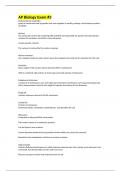
-
AP Biology Exam #3
- Exam (elaborations) • 6 pages • 2024
- Available in package deal
-
- $10.39
- + learn more
AP Biology Exam #3 Endomembrane organelles group of membranes and organelles that work together to modify, package, and transport proteins and lipids Nucleus The central part of the cell containing DNA and RNA and responsible for growth and reproduction - contains the nucleolus, chromatin, and nucleoplasm Contain genetic material The nucleus is enclosed by the nuclear envelope Nuclear envelope Has a double membrane and contains pores that regulate entry and exit of materials ...
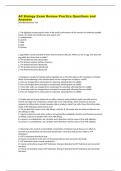
-
AP Biology Exam Review Practice Questions and Answers
- Exam (elaborations) • 42 pages • 2024
-
- $15.39
- + learn more
AP Biology Exam Review Practice Questions and Answers DNA/Biochemestry Test -- 1. The digestive enzyme pepsin works in the acidic environment of the stomach to hydrolyze peptide bonds. On which macromolecules does pepsin act? A. carbohydrate B. protein C. DNA D. lipid B. Protein 2. Egg whites consist primarily of water and the protein albumin. When you fry an egg, why does the egg white turn from clear to white? A. The protein becomes dissociated. B. The protein acquires terti...
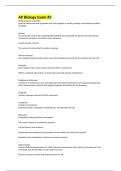
-
AP Biology Exam #3
- Exam (elaborations) • 6 pages • 2024
-
- $9.89
- + learn more
AP Biology Exam #3 Endomembrane organelles group of membranes and organelles that work together to modify, package, and transport proteins and lipids Nucleus The central part of the cell containing DNA and RNA and responsible for growth and reproduction - contains the nucleolus, chromatin, and nucleoplasm Contain genetic material The nucleus is enclosed by the nuclear envelope Nuclear envelope Has a double membrane and contains pores that regulate entry and exit of materials ...
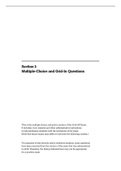
-
AP Bio 2018年真题 (其他年份请加微信454479303)
- Exam (elaborations) • 71 pages • 2022
-
- $10.49
- 2x sold
- + learn more
AP® Biology Exam SECTION I: Multiple Choice and Grid-In 2018 DO NOT OPEN THIS BOOKLET UNTIL YOU ARE TOLD TO DO SO. At a Glance Total Time 1 hour and 30 minutes Number of Questions 58 Percent of Total Score 50% Writing Instrument Pencil required Electronic Device Calculator allowed Instructions Section I of this exam contains 53 multiple choice questions and 5 grid in questions Indicate all of your answers to the Section I questions on the answer sheet No credit will be given fo...
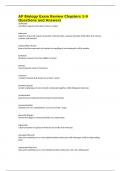
-
AP Biology Exam Review Chapters 1-9 Questions and Answers
- Exam (elaborations) • 8 pages • 2024
-
- $10.39
- + learn more
AP Biology Exam Review Chapters 1-9 Questions and Answers prokaryote unicellular organism that doesn't have a nucleus eukaryote organism whose cell contains its genetic material inside a nucleus (includes all life other than viruses, archaea, and bacteria) endosymbiosis theory theory that the eukaryotic cell evolved via engulfing of one prokaryotic cell by another hydrolysis breaking a polymer from the addition of water polymer macromolecule made of monomers monom...
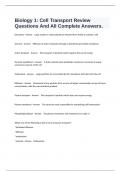
-
Cell Transport Exams Bundle !
- Package deal • 4 items • 2024
-
- $22.47
- + learn more
1 Exam (elaborations) AP Biology Cell Transport Study Guide Exam And Correct Answers. 2 Exam (elaborations) Cell Transport Study Guide Questions And Actual Answers. 3 Exam (elaborations) Cell Transport Midterm Exam Questions Solved Correctly. 4 Exam (elaborations) Biology Cell Transport Pro Test Questions Solved Correctly. 5 Exam (elaborations)

-
AP Biology Exam Bundle (Graded A) 2024
- Package deal • 50 items • 2024
-
- $46.49
- + learn more
1 Exam (elaborations) ULTIMATE AP Biology Exam Review 2024 Questions and Answers 2 Exam (elaborations) Pre-AP Biology Final Exam with correct Answers 2024 3 Exam (elaborations) People to Know - AP Biology Exam Questions and Answers 2024 4 Exam (elaborations) Chapters 1-12 AP Biology Exam Questions and Answers 100% correct 5 Exam (elaborations)
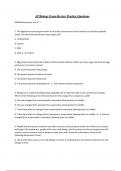
-
AP Biology Exam Review Practice Questions
- Exam (elaborations) • 67 pages • 2024
-
Available in package deal
-
- $9.49
- + learn more
AP Biology Exam Review Practice Questions DNA/Biochemestry Test ️-- 1. The digestive enzyme pepsin works in the acidic environment of the stomach to hydrolyze peptide bonds. On which macromolecules does pepsin act? A. carbohydrate B. protein C. DNA D. lipid ️B. Protein 2. Egg whites consist primarily of water and the protein albumin. When you fry an egg, why does the egg white turn from clear to white? A. The protein becomes dissociated. B. The protein acquires terti...
![AP Biology [Practice AP Exam] Questions and Answers (Graded A)](/docpics/5215127/6639c50ad8739_5215127_121_171.jpeg)
-
AP Biology [Practice AP Exam] Questions and Answers (Graded A)
- Exam (elaborations) • 5 pages • 2024
-
- $9.89
- + learn more
AP Biology [Practice AP Exam] Questions and Answers (Graded A) [D] interactions between amino acids present in the polypeptide. [2] The tertiary structure and function of a polypeptide is principally determined by the: ----------------------------------------------- [A] length of the polypeptide. [B] number of nucleotides present in the polypeptide. [C] repeated units of glycerol making up the polypeptide. [D] interactions between amino acids present in the polypeptide. [E] numbe...
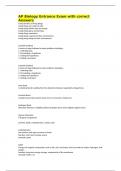
-
AP Biology Entrance Exam with correct Answers
- Exam (elaborations) • 6 pages • 2024
-
- $10.39
- + learn more
AP Biology Entrance Exam with correct Answers Characteristics of living things Living things are made of cells. Living things obtain and use energy. Living things grow and develop. Living things reproduce. Living things respond to their environment. Living things adapt to their environment. Scientific Method A series of steps followed to solve problems including... 1. collecting data 2. formulating a hypothesis 3. testing the hypothesis, 4. stating conclusions. Scientific M...

Study stress? For sellers on Stuvia, these are actually golden times. KA-CHING! Earn from your study resources too and start uploading now. Discover all about earning on Stuvia


